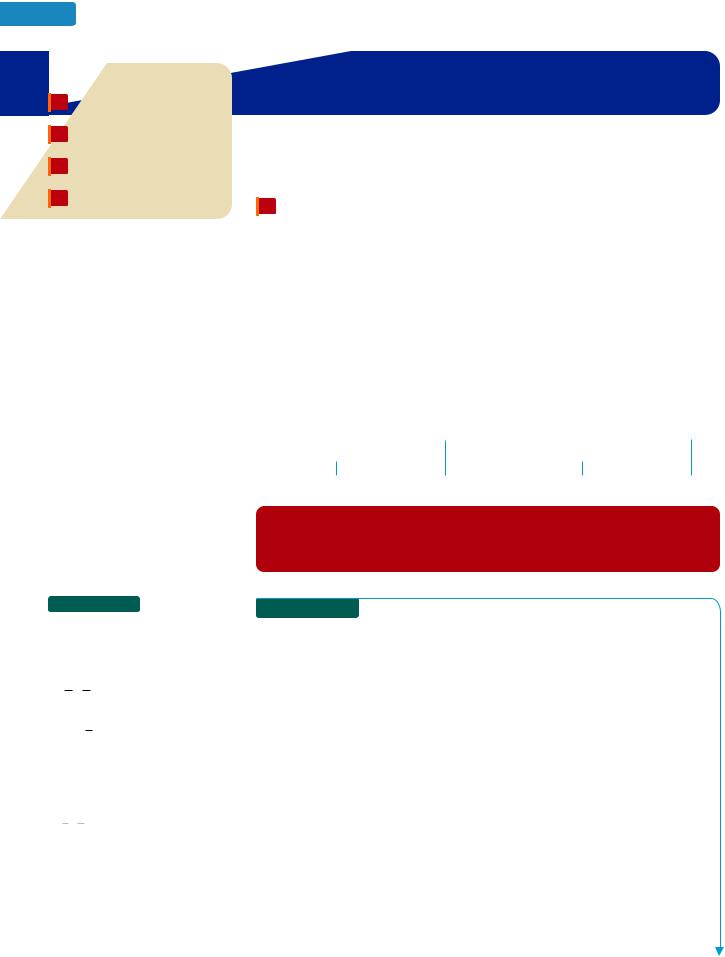
- •Study Skills Workshop
- •1.1 An Introduction to the Whole Numbers
- •1.2 Adding Whole Numbers
- •1.3 Subtracting Whole Numbers
- •1.4 Multiplying Whole Numbers
- •1.5 Dividing Whole Numbers
- •1.6 Problem Solving
- •1.7 Prime Factors and Exponents
- •1.8 The Least Common Multiple and the Greatest Common Factor
- •1.9 Order of Operations
- •THINK IT THROUGH Education Pays
- •2.1 An Introduction to the Integers
- •THINK IT THROUGH Credit Card Debt
- •2.2 Adding Integers
- •THINK IT THROUGH Cash Flow
- •2.3 Subtracting Integers
- •2.4 Multiplying Integers
- •2.5 Dividing Integers
- •2.6 Order of Operations and Estimation
- •Cumulative Review
- •3.1 An Introduction to Fractions
- •3.2 Multiplying Fractions
- •3.3 Dividing Fractions
- •3.4 Adding and Subtracting Fractions
- •THINK IT THROUGH Budgets
- •3.5 Multiplying and Dividing Mixed Numbers
- •3.6 Adding and Subtracting Mixed Numbers
- •THINK IT THROUGH
- •3.7 Order of Operations and Complex Fractions
- •Cumulative Review
- •4.1 An Introduction to Decimals
- •4.2 Adding and Subtracting Decimals
- •4.3 Multiplying Decimals
- •THINK IT THROUGH Overtime
- •4.4 Dividing Decimals
- •THINK IT THROUGH GPA
- •4.5 Fractions and Decimals
- •4.6 Square Roots
- •Cumulative Review
- •5.1 Ratios
- •5.2 Proportions
- •5.3 American Units of Measurement
- •5.4 Metric Units of Measurement
- •5.5 Converting between American and Metric Units
- •Cumulative Review
- •6.2 Solving Percent Problems Using Percent Equations and Proportions
- •6.3 Applications of Percent
- •6.4 Estimation with Percent
- •6.5 Interest
- •Cumulative Review
- •7.1 Reading Graphs and Tables
- •THINK IT THROUGH The Value of an Education
- •Cumulative Review
- •8.1 The Language of Algebra
- •8.2 Simplifying Algebraic Expressions
- •8.3 Solving Equations Using Properties of Equality
- •8.4 More about Solving Equations
- •8.5 Using Equations to Solve Application Problems
- •8.6 Multiplication Rules for Exponents
- •Cumulative Review
- •9.1 Basic Geometric Figures; Angles
- •9.2 Parallel and Perpendicular Lines
- •9.3 Triangles
- •9.4 The Pythagorean Theorem
- •9.5 Congruent Triangles and Similar Triangles
- •9.6 Quadrilaterals and Other Polygons
- •9.7 Perimeters and Areas of Polygons
- •THINK IT THROUGH Dorm Rooms
- •9.8 Circles
- •9.9 Volume
- •Cumulative Review

648 Chapter 8 An Introduction to Algebra
Objectives |
S E C T I O N 8.2 |
1Simplify products.
2Use the distributive property.
3Identify like terms.
4Combine like terms.
Simplifying Algebraic Expressions
In algebra, we frequently replace one algebraic expression with another that is equivalent and simpler in form. That process, called simplifying an algebraic expression, often involves the use of one or more properties of real numbers.
1 Simplify products.
The commutative and associative properties of multiplication can be used to simplify certain products. For example, let’s simplify 8(4x).
8(4x) 8 (4 x) |
Rewrite 4x as 4 x. |
(8 4) x |
Use the associative property of multiplication to group 4 with 8. |
32x |
Do the multiplication within the parentheses. |
We have found that 8(4x) 32x.We say that 8(4x) and 32x are equivalent expressions because for each value of x, they represent the same number. For example, if x 10, both expressions have a value of 320. If x 3, both expressions have a value of 96.
|
If x 10 |
|
If x 3 |
||||
8(4x) 8[4(10)] |
32x 32(10) |
8(4x) 8[4( 3)] |
32x 32( 3) |
||||
8(40) |
320 |
8( 12) |
96 |
||||
320 |
|
|
96 |
|
|||
|
|
|
|||||
|
|
|
|
||||
|
|
|
|
|
|
|
|
|
|
|
|
|
|
|
|
|
same result |
|
same result |
||||
 Self Check 1
Self Check 1
Simplify:
a.9 6s
b.4(6u)( 2)
c.23 32 m
d.36a29 yb
Now Try Problems 15,25,29,and 31
Success Tip By the commutative property of multiplication, we can change the order of factors. By the associative property of multiplication, we can change the grouping of factors.
|
EXAMPLE 1 Simplify: |
|
|
|
|
|
|
|
a. 9(3b) b. 15a(6) c. 3(7p)( 5) d. |
8 |
|
3 |
r |
e. 35a |
4 |
xb |
|
3 |
8 |
|
||||||
|
|
|
|
5 |
|
|||
Strategy We will use the commutative and associative properties of multiplication to reorder and regroup the factors in each expression.
WHY We want to group all of the numerical factors of an expression together so that we can find their product.
Solution
a. 9(3b) (9 3)b |
Use the associative property of multiplication to |
|
|
|
|
regroup the factors. |
|
|
|
||
|
|
|
|
||
27b |
Do the multiplication within the parentheses. |
|
|
|
|
|
Use the commutative property of multiplication to |
|
3 |
||
|
|
||||
b. 15a(6) 15(6)a |
|
15 |
|||
reorder the factors. |
|
||||
|
|
6 |
|||
|
|
|
|
||
90a |
Do the multiplication: 15(6) 90. |
|
90 |
||
|
|
Use the commutative and associative |
|
|
|
c. 3(7p)( 5) [3(7)( 5)]p |
properties of multiplication to reorder |
|
|
|
|
|
|
and regroup the factors. |
|
21 |
|
[21( 5)]p |
Multiply within the brackets. |
|
|||
|
|
5 |
|||
|
|
|
|
||
105p |
Complete the multiplication within the brackets. |
|
105 |
||

8.2 Simplifying Algebraic Expressions |
649 |
d.83 38 r a83 38br
1r
Use the associative property of multiplication to group the factors.
Multiply within the parentheses. |
1 1 |
The product of a number and its reciprocal is 1: 83 83 1 .
r
e. 35a45xb a351 45bx
1 1
The coefficient 1 need not be written.
Use the associative property of multiplication to regroup the factors.
1
a5 1 7 5 4bx Factor 35 as 5 7 and then remove the common factor 5.
|
1 |
|
|
|
28x |
Do the multiplication and then simplify: |
28 |
28. |
|
|
||||
|
|
1 |
|
|
2 Use the distributive property.
Another property that is often used to simplify algebraic expressions is the distributive property. To introduce it, we will evaluate 4(5 3) in two ways.
Method 1 |
Method 2 |
Use the order of operations: |
Distribute the multiplication: |
4(5 3) 4(8) |
4(5 3) 4(5) 4(3) |
32 |
20 12 |
|
32 |
Each method gives a result of 32. This observation suggests the following property.
The Distributive Property
For any numbers a, b, and c,
a(b c) ab ac
The Language of Algebra To distribute means to give from one to several. You have probably distributed candy to children coming to your door on Halloween.
To illustrate one use of the distributive property, let’s consider the expression 5(x 3). Since we are not given the value of x, we cannot add x and 3 within the parentheses. However, we can distribute the multiplication by the factor of 5 that is outside the parentheses to x and to 3 and add those products.
5(x 3) 5(x) 5(3) Distribute the multiplication by 5.
5x 15 |
Do the multiplications. |
The Language of Algebra Formally, it is called the distributive property of multiplication over addition. When we use it to write a product, such as 5(x 2), as a sum, 5x 10, we say that we have removed or cleared the parentheses.

650 |
Chapter 8 An Introduction to Algebra |
 Self Check 2
Self Check 2
Multiply:
a.7(m 2)
b.80(8x 3)
c.24 ay6 38b
Now Try Problems 35, 37, and 39
|
EXAMPLE 2 |
|
|
x |
|
9 |
|
|
Multiply: a. 8(m 9) |
b. 12(4t 1) |
c. 6a |
|
|
|
b |
|
3 |
2 |
Strategy In each case, we will distribute the multiplication by the factor outside the parentheses over each term within the parentheses.
WHY In each case, we cannot simplify the expression within the parentheses. To multiply, we must use the distributive property.
Solution
 Self Check 3
Self Check 3
Multiply:
a.5(2x 1)
b.9( y 4)
c.1(c 22)
Now Try Problems 43, 47, and 49
a.We read 8(m 9) as “eight times the quantity of m plus nine.” The word quantity alerts us to the grouping symbols in the expression.
|
|
8(m 9) 8 m 8 9 Distribute the multiplication by 8. |
|
|
|
|||||||||||
|
|
|
|
|
8m 72 |
|
Do the multiplications. Try to go directly to this step. |
|
||||||||
b. 12(4t 1) 12(4t) ( 12)(1) Distribute the multiplication by 12. |
|
12 |
|
|||||||||||||
|
|
|||||||||||||||
|
|
|
|
|
48t |
( 12) |
Do the multiplications. |
|
4 |
|
||||||
|
|
|
|
|
|
48 |
|
|||||||||
|
|
|
|
|
|
|
|
|
|
|
|
Write the result in simpler form. Recall that |
|
|
||
|
|
|
|
|
48t |
12 |
|
|
|
|||||||
|
|
|
|
|
adding 12 is the same as subtracting 12. |
|
|
|
||||||||
|
|
|
|
|
|
|
|
|
|
|
|
|
|
|
||
|
x |
|
9 |
|
|
x |
|
9 |
|
|
|
|
|
|
||
c. 6a |
|
|
|
b |
6 |
|
6 |
|
|
|
Distribute the multiplication by 6. |
|
|
|
||
3 |
2 |
3 |
2 |
|
|
|
|
|
||||||||
|
|
|
|
|
1 |
|
|
|
1 |
|
|
|
|
|
|
|
|
|
|
|
2 3 x |
|
2 3 9 Factor 6 as 2 3 and then remove |
|
|
|
|||||||
|
|
|
3 |
|
|
|
|
2 |
the common factors 3 and 2. |
|
|
|
||||
|
|
|
|
|
|
|
|
|
|
|
|
|
||||
|
|
|
|
|
1 |
|
|
|
|
|
1 |
|
|
|
|
|
|
|
|
|
2x 27 |
|
|
|
|
|
|
|
|
||||
|
|
|
|
|
|
|
|
|
|
|
|
|||||
|
|
|
|
|
|
|
|
|
|
|
|
|||||
Since subtraction is the same as adding the opposite, the distributive property also holds for subtraction.
a(b c) ab ac
 EXAMPLE 3
EXAMPLE 3
Multiply: a. 3(3b 4) b. 6( 3y 8) c. 1(t 9)
Strategy In each case, we will distribute the multiplication by the factor outside the parentheses over each term within the parentheses.
WHY In each case, we cannot simplify the expression within the parentheses. To multiply, we must use the distributive property.
Solution
a. 3(3b 4) 3(3b) |
3(4) |
Distribute the multiplication by 3. |
9b 12 |
|
Do the multiplications. Try to go directly to this step. |
Caution! A common mistake is to forget to distribute the multiplication over each of the terms within the parentheses.
3(3b 4) 9b 4

8.2 Simplifying Algebraic Expressions |
651 |
b.6( 3y 8) 6( 3y) ( 6)(8)
18y ( 48)
18y 48
Distribute the multiplication by 6.
Do the multiplications.
Write the result in simpler form. Add the opposite of 48.
Another approach is to write the subtraction within the parentheses as addition of the opposite. Then we distribute the multiplication by 6 over the addition.
6( 3y 8) 6[ 3y ( 8)] |
Add the opposite of 8. |
6( 3y) ( 6)( 8) |
Distribute the multiplication by 6. |
18y 48 |
Do the multiplications. |
c.1(t 9) 1(t) ( 1)(9)
t ( 9)
t 9
Distribute the multiplication by 1.
Do the multiplications.
Write the result in simpler form. Add the opposite of 9.
Notice that distributing the multiplication by 1 changes the sign of each term within the parentheses.
Caution! The distributive property does not apply to every expression that contains parentheses—only those where multiplication is distributed over addition (or subtraction). For example, to simplify 6(5x), we do not use the distributive property.
Correct |
Incorrect |
6(5x) (6 5)x 30x |
6(5x) 30 6x 180x |
The distributive property can be extended to several other useful forms. Since multiplication is commutative, we have:
(b c)a ba ca |
(b c)a ba ca |
For situations in which there are more than two terms within parentheses, we have:
|
a(b c d) ab ac ad |
a(b c d) ab ac ad |
|||
|
EXAMPLE 4 |
Multiply: |
|
||
|
|
||||
a. (6x 4) |
1 |
|
b. 2(a 3b)8 |
c. 0.3(3a 4b 7) |
|
|
|||||
2 |
|
|
|
||
Strategy We will multiply each term within the parentheses by the factor (or factors) outside the parentheses.
WHY In each case, we cannot simplify the expression within the parentheses. To multiply, we use the distributive property.
 Self Check 4
Self Check 4
Multiply:
a.( 6x 24)13
b.6(c 2d)9
c.0.7(2r 5s 8)
Now Try Problems 53, 55, and 57
Solution
a. (6x 4) |
1 |
(6x) |
1 |
(4) |
1 |
Distribute the multiplication by |
1 |
. |
|
2 |
2 |
2 |
|||||||
|
|
|
|
2 |
|||||
|
|
3x 2 |
|
Do the multiplications. |
|
|
|||

652 |
Chapter 8 An Introduction to Algebra |
|
|
b. This expression contains three factors. |
Use the commutative property of |
|
2(a 3b)8 2 8(a 3b) |
multiplication to reorder the factors. |
|
|
16(a 3b) Multiply 2 and 8 to get 16.
16a 48b Distribute the multiplication by 16.
c.0.3(3a 4b 7) 0.3(3a) ( 0.3)(4b) ( 0.3)(7)
0.9a 1.2b 2.1 Do each multiplication.
1
0.30.3
3 4
0.91.2
2
0.3
7 2.1
We can use the distributive property to find the opposite of a sum. For example, to find (x 10), we interpret the symbol as a factor of 1, and proceed as follows:
|
|
|
|
|
|
|
|
||||
(x 10) 1(x 10) |
Replace the symbol with 1. |
||||
|
|
|
1(x) ( 1)(10) |
Distribute the multiplication by 1. |
|
|
|
|
x 10 |
|
|
In general, we have the following property.
 Self Check 5
Self Check 5
Simplify: ( 5x 18)
Now Try Problem 59
The Opposite of a Sum
The opposite of a sum is the sum of the opposites.
For any numbers a and b,
(a b) a ( b)
EXAMPLE 5 Simplify: ( 9s 3)
Strategy We will multiply each term within the parentheses by 1.
WHY The outside the parentheses represents a factor of 1 that is to be distributed.
Solution
( 9s 3) 1( 9s 3) |
Replace the symbol in front |
|
of the parentheses with 1. |
|
|
|
|
|
1( 9s) ( 1)(3) |
Distribute the multiplication by 1. |
|
9s 3 |
Do the multiplications. Try to go |
|
|
directly to this step. |
|
|
|
3 Identify like terms.
Before we can discuss methods for simplifying algebraic expressions involving addition and subtraction, we need to introduce some new vocabulary.
Like Terms
Like terms are terms containing exactly the same variables raised to exactly the same powers. Any constant terms in an expression are considered to be like terms. Terms that are not like terms are called unlike terms.

|
|
|
|
|
|
|
|
8.2 Simplifying Algebraic Expressions |
653 |
Here are several examples. |
|
|
|
|
|||||
|
Like terms |
Unlike terms |
|
|
|||||
|
4x and 7x |
|
|
4x and 7y |
|
The variables are not the same. |
|
||
|
10p2 and 25p2 |
|
10p and 25p2 |
Same variable, but different powers. |
|
||||
1 |
3 |
3 |
1 |
3 |
3 |
|
|
||
|
|
c d and c d |
|
|
c d and c |
|
The variables are not the same. |
|
|
3 |
|
3 |
|
|
|||||
Success Tip When looking for like terms, don’t look at the coefficients of the terms. Consider only the variable factors of each term. If two terms are like terms, only their coefficients may differ.
|
EXAMPLE 6 |
Identify the like terms in each expression: |
a. 7r 5 3r |
b. 6x4 6x2 6x c. 17m3 3 2 m3 |
|
Strategy First, we will identify the terms of the expression. Then we will look for terms that contain the same variables raised to exactly the same powers.
WHY If two terms contain the same variables raised to the same powers, they are like terms.
 Self Check 6
Self Check 6
Identify the like terms:
a.2x 2y 7y
b.5p2 12 17p2 2
Now Try Problem 63
Solution
a.7r 5 3r contains the like terms 7r and 3r.
b.Since the exponents on x are different, 6x4 6x2 6x contains no like terms.
c.17m3 3 2 m3 contains two pairs of like terms: 17m3 and m3 are like
terms, and the constant terms, 3 and 2, are like terms.
4 Combine like terms.
To add or subtract objects, they must be similar. For example, fractions that are to be added must have a common denominator.When adding decimals, we align columns to be sure to add tenths to tenths, hundredths to hundredths, and so on. The same is true when working with terms of an algebraic expression.They can be added or subtracted only if they are like terms.
This expression can be simplified |
This expression cannot be simplified |
because it contains like terms. |
because its terms are not like terms. |
3x 4x |
3x 4y |
Recall that the distributive property can be written in the following forms:
(b c)a ba ca (b c)a ba ca
We can use these forms of the distributive property in reverse to simplify a sum or difference of like terms. For example, we can simplify 3x 4x as follows:
3x 4x (3 4)x Use the form: ba ca (b c)a.
7x
Success Tip Just as 3 apples plus 4 apples is 7 apples,
3x 4x 7x

654 |
Chapter 8 An Introduction to Algebra |
We can simplify 15m2 9m2 in a similar way:
15m2 9m2 (15 9)m2 Use the form: ba ca (b c)a.
6m2
The Language of Algebra Simplifying a sum or difference of like terms is called combining like terms.
These examples suggest the following general rule.
Combining Like Terms
Like terms can be combined by adding or subtracting the coefficients of the terms and keeping the same variables with the same exponents.
 Self Check 7
Self Check 7
Simplify, if possible:
a.3x 5x
b.6y ( 6y) 9y
c.4.4s4 3.9s4
d.4a 2
104 e. 7 c 7 c
Now Try Problems 67,71,79,and 83
|
EXAMPLE 7 Simplify by combining like terms, if possible: |
|
|
|
|
|
a. 2x 9x b. 8p ( 2p) 4p c. 0.5s3 0.3s3 d. 4w 6 e. |
4 |
b |
7 |
b |
||
9 |
9 |
|||||
|
|
|
|
|||
Strategy We will use the distributive property in reverse to add (or subtract) the coefficients of the like terms. We will keep the same variables raised to the same powers.
WHY To combine like terms means to add or subtract the like terms in an expression.
Solution
 Self Check 8
Self Check 8
Simplify:
a. 9h h |
b. 9h h |
c. 9h 8h |
d. 8h 9h |
Now Try Problems 73 and 77
a.Since 2x and 9x are like terms with the common variable x, we can combine them.
2x 9x 11x Think: (2 9)x 11x.
b. 8p ( 2p) 4p 6p Think: [ 8 ( 2) 4]p 6p. c. 0.5s3 0.3s3 0.2s3 Think: (0.5 0.3)s3 0.2s3.
d.Since 4w and 6 are not like terms, they cannot be combined. The expression 4w 6 doesn’t simplify.
e. |
|
4 |
b |
7 |
b |
11 |
b |
Think: 1 |
4 |
7 |
2b 11b. |
|
|
9 |
9 |
9 |
|
||||||||||
|
|
|
|
|
|
9 |
9 |
9 |
|
||||
|
|
EXAMPLE 8 |
Simplify by combining like terms: |
|
|||||||||
|
|
|
|||||||||||
a. |
16t 15t |
b. |
16t t |
|
c. |
15t 16t d. 16t t |
|
||||||
Strategy As we combine like terms, we must be careful when working with terms such as t and t.
WHY Coefficients of 1 and 1 are usually not written.
Solution
a.16t 15t t Think: (16 15)t 1t t.
b.16t t 15t Think: 16t 1t (16 1)t 15t.
c.15t 16t t Think: (15 16)t 1t t.
d.16t t 17t Think: 16t 1t (16 1)t 17t.

|
|
|
8.2 Simplifying Algebraic Expressions |
655 |
|||||
|
EXAMPLE 9 |
Simplify: 6a2 54a |
4a 36 |
|
Self Check 9 |
|
|||
|
|
|
|||||||
|
Simplify: 7y2 21y 2y 6 |
|
|||||||
Strategy First, we will identify any like terms in the expression. Then we will use |
|
||||||||
Now Try |
Problem 93 |
|
|||||||
the distributive property in reverse to combine them. |
|
||||||||
|
|
|
|
||||||
WHY To simplify an expression we use properties of real numbers to write an |
|
|
|
|
|||||
equivalent expression in simpler form. |
|
|
|
|
|
|
|
||
Solution |
|
|
|
|
|
|
|
|
|
We can combine the like terms that involve the variable a. |
|
|
|
|
|||||
|
6a2 54a 4a 36 6a2 50a 36 |
Think: (54 4)a 50a. |
|
|
|
|
|
|
|
|
|
|
|
|
|
||||
EXAMPLE 10 Simplify: 4(x 5) 5 (2x 4)
Strategy First, we will remove the parentheses. Then we will identify any like terms and combine them.
WHY To simplify an expression we use properties of real numbers, such as the distributive property, to write an equivalent expression in simpler form.
Solution
Here, the distributive property is used both forward (to remove parentheses) and in reverse (to combine like terms).
Replace the symbol
4(x 5) 5 (2x 4) 4(x 5) 5 1(2x 4) in front of (2x 4) with 1.
4x 20 5 2x 4
Distribute the multiplication by 4 and 1.
Think: (4 2)x 2x.
2x 19
Think: (20 5 4) 19.
|
ANSWERS TO SELF CHECKS |
|
|
|
|
|
|||||
|
|
|
|
|
|
||||||
|
1. |
a. 54s |
b. |
48u |
c. m |
d. 8y 2. a. |
7m 14 |
b. 640x 240 c. 4y 9 |
|||
|
3. |
a. 10x 5 |
b. |
9y 36 |
c. c 22 4. a. 2x 8 |
b. 54c 108d |
|||||
|
c. |
1.4r 3.5s 5.6 |
5. |
5x 18 6. |
a. 2y and 7y |
b. |
5p2 and 17p2; 12 and 2 |
||||
|
7. |
a. 8x |
b. 3y |
c. |
0.5s4 d. does not simplify |
e. 76 c |
8. a. 8h b. 10h c. h |
||||
|
d. |
h 9. |
7y2 19y 6 |
10. 21y 8 |
|
|
|
|
|||
|
|
|
|
|
|
|
|
|
|
|
|
 Self Check 10
Self Check 10
Simplify:
6(3y 1) 2 ( 3y 4)
Now Try Problem 99
|
S E C T I O N |
8.2 |
STUDY SET |
||||||||
|
|
|
VOCABULARY |
|
|
||||||
|
|
|
|
|
|||||||
|
|
|
|
|
|||||||
|
Fill in the blanks. |
|
|
||||||||
1. |
|
To |
|
|
the expression 5(6x) means to write it in |
||||||
|
|
|
|
simpler form: 5(6x) 30x. |
|||||||
2. |
|
5(6x) and 30x are |
|
|
expressions because for |
||||||
|
|
|
|
each value of x, they represent the same number. |
|||||||
3. |
|
To perform the multiplication 2(x 8), we use the |
|||||||||
|
|
|
|
|
|
|
|
property. |
|
|
|
4. We call (c 9) the |
|
of a sum. |
5.Terms such as 7x2 and 5x2, which have the same variables raised to exactly the same power, are called
terms.
6.When we write 9x x as 10x, we say we have
like terms.

656 |
Chapter 8 An Introduction to Algebra |
CONCEPTS
7.a. Fill in the blanks to simplify the expression. 4(9t) (
 )t
)t  t
t
b. What property did you use in part a?
8.a. Fill in the blanks to simplify the expression.
6y 2 
 y
y  y
y
b.What property did you use in part a?
9.Fill in the blanks.
a.2(x 4) 2x  8
8
b.2(x 4) 2x  8
8
c.2(x 4) 2x  8
8
d.2( x 4) 2x  8
8
10.Fill in the blanks to combine like terms.
a.4m 6m (
 )m
)m  m
m
b.30n2 50n2 (
 )n2
)n2  n2
n2
c.12 32d 15 32d 
d.Like terms can be combined by adding or
|
subtracting the |
|
|
|
|
of the terms and |
|
keeping the same |
|
|
|
with the same |
|
|
exponents. |
|
|
|
|
|
11. Simplify each expression, if possible. |
||||||
a. |
5(2x) |
b. |
5 2x |
|||
c. |
6( 7x) |
d. 6 7x |
||||
e. |
2(3x)(3) |
f. |
2 3x 3 |
|||
12. Fill in the blanks: Distributing multiplication by 1
changes the |
|
of each term within the parentheses. |
|||
(x 10) |
|
(x 10) x |
|
10 |
|
|
|
||||
NOTATION
13.Translate to symbols.
a.Six times the quantity of h minus four.
b.The opposite of the sum of z and sixteen.
14.Write an equivalent expression for the given expression using fewer symbols.
a. 1x |
b. 1d |
c. 0m |
d. 5x |
( 1) |
e. 16t ( 6) |
GUIDED PRACTICE
Simplify. See Example 1. |
|
|
|
|
|
|
|
|
|
|
|
|
|||||||||||||
15. |
3 4t |
|
|
|
|
16. |
9 3s |
|
|
|
|||||||||||||||
17. |
9(7m) |
|
|
|
|
18. |
12n(8) |
|
|
|
|||||||||||||||
19. |
5( 7q) |
|
|
|
|
20. |
7(5t) |
|
|
|
|||||||||||||||
21. |
5t 60 |
|
|
|
|
22. |
70a 10 |
|
|
|
|||||||||||||||
23. |
( 5.6x)( 2) |
24. |
( 4.4x)( 3) |
||||||||||||||||||||||
25. |
5(4c)(3) |
|
|
|
|
26. |
9(2h)(2) |
|
|
|
|||||||||||||||
27. |
4( 6)( 4m) |
28. |
5( 9)( 4n) |
||||||||||||||||||||||
29. |
5 |
3 |
g |
|
|
|
|
30. |
9 |
7 |
k |
|
|
|
|||||||||||
|
|
|
|
|
|
|
|
|
|
|
|
|
|||||||||||||
3 |
5 |
|
|
|
|
7 |
9 |
|
|
|
|||||||||||||||
|
|
5 |
|
|
|
|
|
|
|
|
|
4 |
|
|
|
|
|
||||||||
31. |
12a |
|
|
xb |
32. |
15a |
|
|
wb |
||||||||||||||||
12 |
15 |
||||||||||||||||||||||||
|
|
3 |
|
|
|
|
|
|
|
|
|
|
|
|
2 |
|
|
|
|
|
|
||||
33. |
8a |
|
|
yb |
|
|
|
|
34. |
27a |
|
|
xb |
|
|
|
|||||||||
4 |
|
|
|
|
3 |
|
|
|
|||||||||||||||||
Multiply. See Example 2. |
|
|
|
|
|
|
|
|
|
|
|
|
|||||||||||||
35. |
5(x 3) |
|
|
|
|
36. |
4(x 2) |
|
|
|
|||||||||||||||
37. |
3(4x 9) |
38. |
5(8x 9) |
||||||||||||||||||||||
39. |
45a |
x |
2 |
|
|
40. |
35a |
y |
8 |
|
|
||||||||||||||
|
|
|
|
|
b |
|
|
|
|
|
b |
||||||||||||||
5 |
9 |
5 |
|
7 |
|||||||||||||||||||||
41. |
0.4(x 4) |
42. |
2.2(2q 1) |
||||||||||||||||||||||
Multiply. See Example 3. |
|
|
|
|
|
|
|
|
|
|
|
|
|||||||||||||
43. |
6(6c 7) |
44. |
9(9d 3) |
||||||||||||||||||||||
45. |
6(13c 3) |
46. |
2(10s 11) |
||||||||||||||||||||||
47. |
15( 2t 6) |
48. |
20( 4z 5) |
||||||||||||||||||||||
49. |
1( 4a 1) |
50. |
1( 2x 3) |
||||||||||||||||||||||
Multiply. See Example 4. |
|
|
|
|
|
|
|
|
|
|
|
|
|||||||||||||
51. |
(3t 2)8 |
52. |
(2q 1)9 |
||||||||||||||||||||||
53. |
(3w 6) |
2 |
|
54. |
(2y 8) |
1 |
|
||||||||||||||||||
|
|
2 |
|
||||||||||||||||||||||
|
|
|
|
|
|
|
|
|
|
3 |
|
|
|
|
|
|
|
|
|
|
|
||||
55. |
4(7y 4)2 |
56. |
8(2a 3)4 |
||||||||||||||||||||||
57. |
25(2a 3b 1) |
58. |
5(9s 12t 3) |
||||||||||||||||||||||
Simplify. See Example 5. |
|
|
|
|
|
|
|
|
|
|
|
|
|||||||||||||
59. |
(x 7) |
60. |
(y 1) |
||||||||||||||||||||||
61. |
( 5.6y 7) |
62. |
( 4.8a 3) |
||||||||||||||||||||||
Identify the like terms in each expression, if any.
See Example 6.
63.3x 2 2x
64.3y 4 11y 6
65.12m4 3m3 2m2 m3
66.6x3 3x2 6x

Simplify by combining like terms. See Examples 7 and 8.
67. |
3x 7x |
68. |
12y 15y |
|||||||||||||||
69. |
4x 4x |
70. |
16y 16y |
|||||||||||||||
71. |
7b2 27b2 |
72. |
2c3 12c3 |
|||||||||||||||
73. |
13r 12r |
74. |
25s s |
|||||||||||||||
75. |
36y y 9y |
76. |
32a a 5a |
|||||||||||||||
77. |
43s3 44s3 |
78. |
8j3 9j3 |
|||||||||||||||
79. |
9.8c 6.2c |
80. |
5.7m 4.3m |
|||||||||||||||
81. |
0.2r ( 0.6r) |
82. |
1.1m ( 2.4m) |
|||||||||||||||
83. |
3 |
t |
1 |
t |
84. |
3 |
|
x |
5 |
|
x |
|||||||
5 |
5 |
16 |
|
16 |
||||||||||||||
|
7 |
|
3 |
|
|
5 |
|
7 |
|
|||||||||
85. |
|
|
x |
|
x |
86. |
|
|
|
x |
|
|
|
x |
||||
16 |
16 |
18 |
18 |
|||||||||||||||
Simplify by combining like terms, if possible. See Example 9.
87. |
15y 10 y 20y |
88. |
9z 7 z 19z |
89. |
3x 4 5x 1 |
90. |
4b 9 9b 9 |
91. |
6m2 6m 6 |
92. |
9a2 9a 9 |
93. |
4x2 5x 8x 9 |
94. |
10y2 8y y 7 |
Simplify. See Example 10.
95.2z 5(z 3)
96.12(m 11) 11
97.2(s2 7) (s2 2)
98.4(d2 3) (d2 1)
99.9(3r 9) 7(2r 7)
100.6(3t 6) 3(11t 3)
101.36a29 x 34b 36a12b
102.40a38 y 14b 40a45b
TRY IT YOURSELF
Simplify each expression.
103. 6 4( 3c 7)
105. 4r 7r 2r r
107. 24a 56 rb
109. a a a
111. 60a203 r 154 b
113. 5( 1.2x)
104. 10 5( 5g 1)
106. v 3v 6v 2v
3 1
108.4 2 g
110. t t t t
112. 72a78ƒ 89b
114. 5( 6.4c)
|
|
8.2 Simplifying Algebraic Expressions |
657 |
|
115. |
(c 7) 2(c 3) |
|
||
116. |
(z 2) 5(3 z) |
|
||
117. |
a3 2a2 4a 2a2 4a 8 |
|
||
118. |
c3 3c2 9c 3c2 9c 27 |
|
||
|
APPLICATIONS |
|
||
|
|
|||
In Exercises 119–122, recall that the perimeter of a figure is |
|
|||
equal to the sum of the lengths of its sides. |
|
|||
119. |
THE RED CROSS In 1891, Clara |
|
|
|
|
|
|||
|
|
Barton founded the Red Cross. Its |
|
|
|
|
|
|
|
symbol is a white flag bearing a red |
x |
|
|
|
|
cross. If each side of the cross has length |
|
|
|
|
|
x, write an expression that represents the perimeter of the cross.
120.BILLIARDS Billiard tables vary in size, but all tables are twice as long as they are wide.
a.If the billiard table is x feet wide, write an expression that represents its length.
b.Write an expression that represents the perimeter of the table.
121.PING-PONG Write an expression that represents the perimeter of the Ping-Pong table.
x ft
|
|
ft |
|
|
4) |
x |
ft |
+ |
( |
||
|
x |
|
|
|
122. SEWING Write
an expression that |
(2x |
– |
|
represents the |
|
15) |
cm |
|
|
||
|
|
|
|
length of the yellow |
x cm |
|
|
trim needed to |
|
|
cm |
outline a pennant |
x– |
||
|
(2 |
15) |
|
|
|
|
|
with the given side lengths.
WRITING
123.Explain why the distributive property applies to 2(3 x) but not to 2(3x).
124.Explain how to combine like terms. Give an example.
REVIEW
Evaluate each expression for x 3, y 5, and z 0.
|
x y2 |
|
2y 1 |
|
125. |
|
126. |
|
x |
2y 1 x |
x |
|||
